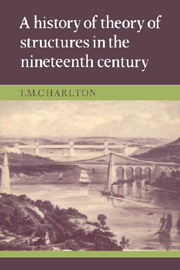Book contents
- Frontmatter
- Contents
- Preface
- 1 Introduction
- 2 Beam systems
- 3 Theory of the arch and suspension bridge
- 4 Elementary theory of frameworks: graphical statics
- 5 Theory of statically-indeterminate frameworks: the reciprocal theorem
- 6 Levy's theory of frameworks and bridge girders
- 7 Early developments of energy principles relating to theory of structures
- 8 The later development and use of energy principles
- 9 Applications of the least work principle: elastic theory of suspension bridges
- 10 Aspects of the further development of theory of structures
- 11 Secondary effects in structures
- Appendices
- Bibliography
- Name index
- Subject index
7 - Early developments of energy principles relating to theory of structures
Published online by Cambridge University Press: 18 September 2009
- Frontmatter
- Contents
- Preface
- 1 Introduction
- 2 Beam systems
- 3 Theory of the arch and suspension bridge
- 4 Elementary theory of frameworks: graphical statics
- 5 Theory of statically-indeterminate frameworks: the reciprocal theorem
- 6 Levy's theory of frameworks and bridge girders
- 7 Early developments of energy principles relating to theory of structures
- 8 The later development and use of energy principles
- 9 Applications of the least work principle: elastic theory of suspension bridges
- 10 Aspects of the further development of theory of structures
- 11 Secondary effects in structures
- Appendices
- Bibliography
- Name index
- Subject index
Summary
This chapter is concerned primarily with principles involving energy concepts, which were revived or formulated early in the nineteenth century within the science of statics and the theory of elastic structures. Principles relating to energy, which were implicitly available at the beginning of the century, included the principle of virtual work (known then as the principle of virtual velocities) and the supreme law of conservation of energy.
Early history
According to Dugas (1955), the use of the principle of virtual velocities can be traced to Jordanus of Nemore in the thirteenth century (and to Aristotle's law of powers of the fourth century b.c.). A revealing account of the principle is provided by Mach (1883) and it is remarkable that the principle, and its use, preceded explicit recognition of conservation of energy. Mach discusses the meaning of the terminology at some length: he ascribes it to John Bernoulli and notes that the word ‘virtual’ is used in the sense of something which is physically possible. Bernoulli's definition of vitesse virtuelle is said by Mach to be incorporated in Thomson & Tait's wording: ‘If the point of application of a force be displaced through a small space, the resolved part of the displacement in the direction of the force has been called its virtual velocity.’ It is believed that the truth of the principle was first noted explicitly by Stevinus, at the close of the sixteenth century, in connection with his research into the equilibrium of systems of pulleys.
- Type
- Chapter
- Information
- A History of the Theory of Structures in the Nineteenth Century , pp. 106 - 117Publisher: Cambridge University PressPrint publication year: 1982



